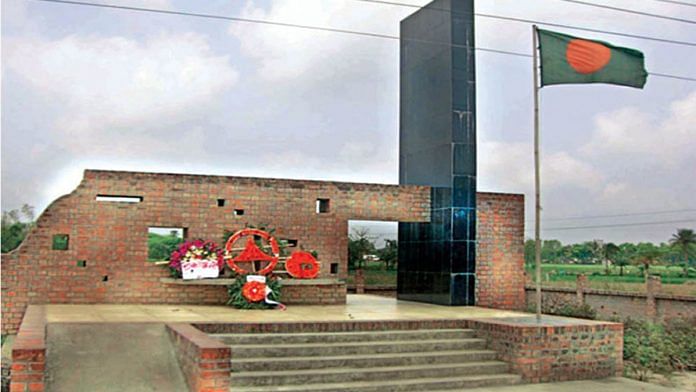New Delhi: While Bangladesh celebrated 50 years of independence in March this year, it commemorated a lesser-known chapter of the country’s 1971 Liberation War — the Chuknagar massacre — Thursday.
On 20 May 1971, an estimated 10,000 people, including children, were killed by Pakistani forces in the small town Chuknagar, under the Dumuria ‘upazila’ (administrative sub-unit) in the Khulna district. Most of the deceased belonged to the Hindu community.
The town of Chuknagar was adjacent to the Indian border and at the time, it was used by several people to flee to India. Those who lost their lives in the massacre had, reportedly, gathered from nearby districts in the town to escape to India.
During a webinar marking the tragedy Thursday, Bangladeshi writer-journalist Shahriar Kabir said, “Within only 5 hours, 10 to 12 thousand innocent people, who were resting there before fleeing to India to save their lives, were killed.”
A few days after the massacre, on 26 March 1971, Bangladesh declared its independence from Pakistan, triggering a liberation war that led to the deaths of an estimated 3 million people.
On 16 December 1971, the Pakistani Army surrendered to the country’s freedom fighters and Indian soldiers, marking the founding of the new nation of Bangladesh.
Since then, 20 May has been observed as the Chuknagar Genocide Day in the town, and the ‘Chuknagar Smrity Rakkha Parishad’ arranges different programmes to mark the day.
In a tweet Thursday, former Tripura Governor Tathagata Roy recalled the Chuknagar massacre and said that “Jallianwala Bagh pales in comparison”. Roy had made similar comments in 2016, when he pointed out that 1,500 people were killed in the 1919 Jallianwala Bagh Massacre while the number was far greater during the Chuknagar massacre.
Today,20th May,is the 50th anniversary of the Chuknagar massacre. Undoubtedly the worst case of mass murder in South Asia-even Jallianwala Bagh pales in comparison. The victims are estimated to be 10,000,all Bengali Hindus,mostly scheduled castes. The mass murderers were the
— Tathagata Roy (@tathagata2) May 20, 2021
Also read: How this Indian Army officer rescued Sheikh Hasina & family from Pakistan Army captors in 1971
What happened during the 1971 Chuknagar Genocide?
Even though the Chuknagar massacre was one of the most deadly episodes of the Bangladesh Liberation War, there is little scholarship available on it.
In his book ‘1971 Chuknagar Genocide‘, one of the few on the event, Bangladeshi scholar Professor Muntassir Mamoon described the massacre in detail and wrote: “At around 10am two trucks carrying Pakistani troops arrived at Kautala then known as Patkhola. The Pakistani troops were not many in number, most possibly a platoon or so.”
“As soon as the trucks stopped, the Pakistani troops alighted carrying light machine guns (LMGs) and semi-automatic rifles and opened fire on the public. Within a few minutes, a lively town turned into a city of death,” he added.
Abdul Haque, a student at that time, was quoted by Dhaka Tribune as saying that there were bodies everywhere and the tide of blood was falling into the Bhadra River.
The Bengali armed resistance was the strongest in rural areas like Chuknagar, but the Pakistani military still burned and destroyed several villages, killing or displacing their residents. Large-scale looting of refugees’ properties also took place at the time.
Documentary photojournalist Turjoy Chowdhury, who tried to map the genocide two years ago, said the very first Razakar camp and concentration centre was set up in Khulna.
Razakar was an East Pakistani paramilitary force organised by the Pakistan Army during the Bangladesh Liberation War in 1971.
Not enough research on Chuknagar massacre
Since there is little scholarship available on the massacre, several aspects remain unclear.
Mamoon himself pointed out that the recorded history of the Liberation War does not mention this massacre.
Indian-American academic Sarmila Bose also shared a similar concern in her book Dead Reckoning: Memories of the 1971 Bangladesh War.
Bose wrote that apart from the fact that the massacre was “targeted to kill adult Hindu males..[e]very other aspect of the Chuknagar killing, however, remains shrouded in uncertainty”.
Also read: What is the 1971 war legacy behind Alouette-Sabre exchange between IAF, Bangladesh air force



